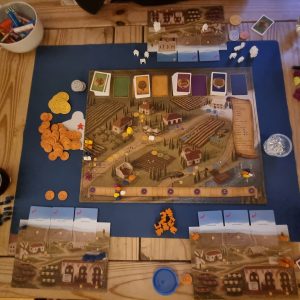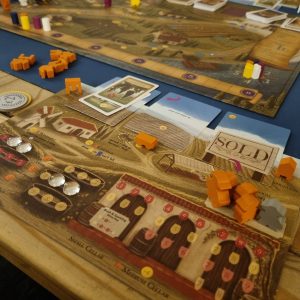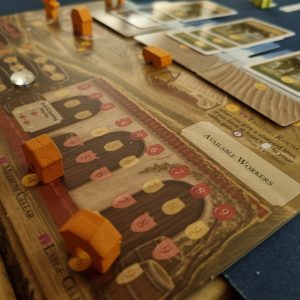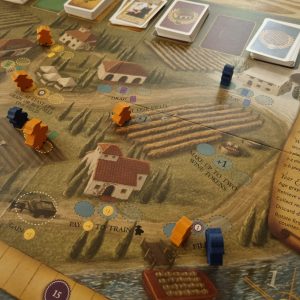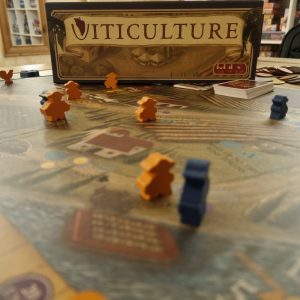Pour a glass of your finest vintage and settle back; Viticulture from Stonemaier Games is an education in full bodied, delicious decision making!
Viticulture Essential Edition
Publisher: Stonemaier Games
Designer: Jamey Stegmaier, Alan Stone
Artist: Jacqui Davis, David Montgomery, Beth Sobel
Release date: 2015
1-6 Players
Age: 13+
60-90 mins
Favouritefoe score: 9/10
Veni, Vidi…….Viti!
I came, I saw, I made wine!!!
Okay, so technically viti means grape or vine. But “I graped” or “I vined” doesn’t have quite the same ring to it. Either way, I definitely used both to make lots and lots of lovely wine!
And that’s handy, because Viticulture is all about transforming an old, dry, vineyard in Tuscany into a booming destination winery! In fact, it’s all about being the first oenophile around the table to do it!
Rhine Roots!
By way of a little background, the original Viticulture game came to life back in 2013 following a successful Kickstarter campaign. Then in 2015, a big expansion called Tuscany was released. This had some hefty modules that upped the ante across the board (pun intended!). But it transpired that a select few of the Tuscan add-ons really made the base game shine brighter.
And so, in direct response to this, Stonemaier Games (love a publisher that actually listens to feedback!) released the Viticulture Essential edition later that same year. It included most of the original 2013 game plus some (but not all) of the extra bits and bobs from Tuscany. Tuscany expansion (replete with all the weighty extras) became Tuscany Essential Edition and that now adds new boards and other ways to mix up your Merlot making. Since then, a further two expansions have also been released (Moor Visitors (2016) and Visit from the Rhine Valley (2018)).
But I’ll stick with just Viticulture Essential Edition (or “Viticulture” here) as that is what I have been playing (although I have a funny feeling it won’t be long before the completionist in me is off exploring extra ways to extend my grape growing prowess!).
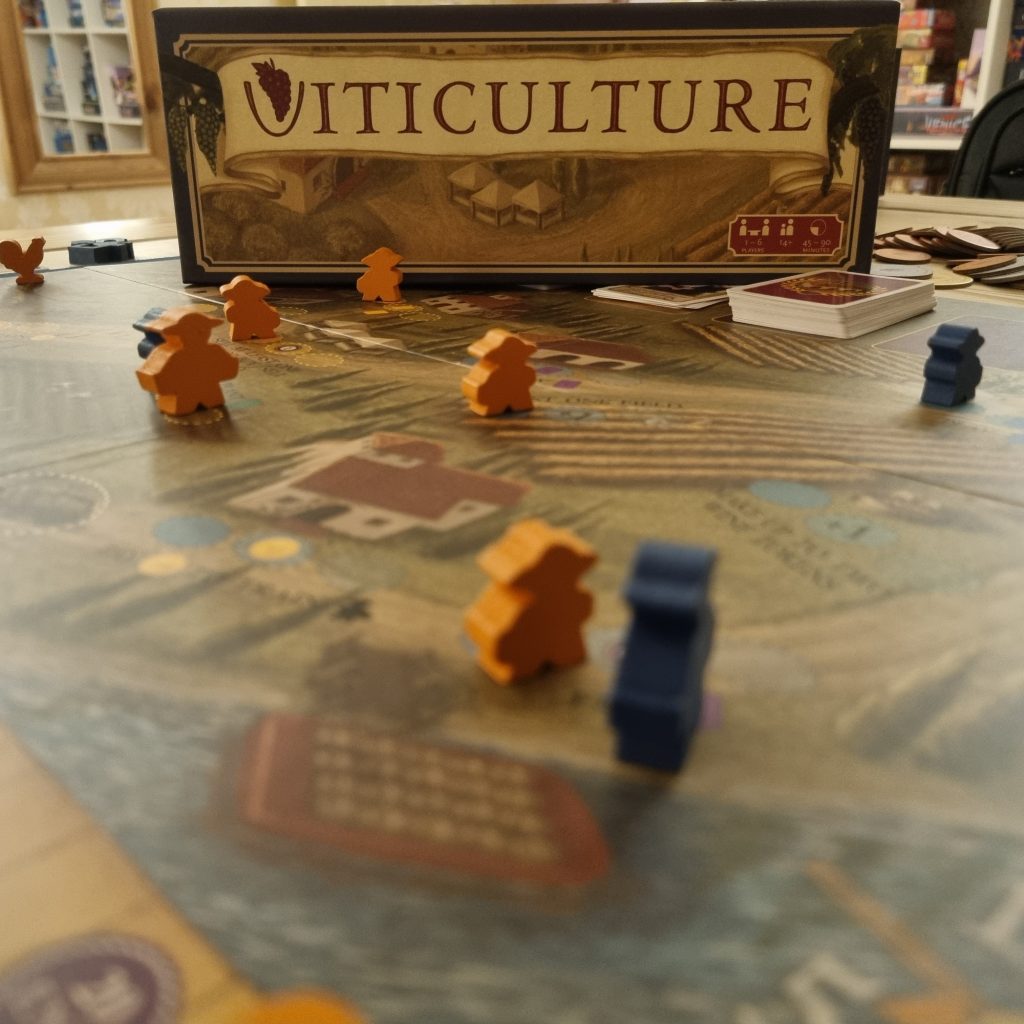
Work those Wines!
At its very core, Viticulture is a straightforward worker placement game. You have a small group of loyal grape gatherers and you deploy them over the seasons of a year in the hope of turning glorious grapes into glug-worthy wines.
As we very quickly found out, however, there is a jeroboam of strategy maturing under the box lid. And by that I mean Viticulture is a heady hit of strategic trade-offs. From your very first move, where you choose your turn order for the year, to your very last attempt at squeezing points out in the depths of the coldest winter, Viticulture has you weighing up your options.
And what juicy choices there are! Well, sometimes. When your opposing vintners aren’t hellbent on smashing your dreams of being the no.1 vineyard in the region! Which is All.The.Time. So don’t get planning too far ahead, for you will be crushingly disappointed.
I will say, however, that when it happens (and at some point it always does), the crushing comes cool and crisp. Like a chilled Chardonnay, the pain when someone takes your desired “spot” is absolutely there (especially at 2 player count – more on that later). But the hurt is made somehow palatable. Maybe because the game is wonderfully calm to behold. Or maybe because Viticulture offers subtle but refreshing opportunities for revenge down the line. Promises of winey ways to get your own back on opposing oenophiles calms the fire burning within.
As well as workers, the other big mechanic in Viticulture is hand management. You are going to get cards. Hopefully lots of them. All different types; vines, wine orders, even characters. But, again, deciding what to do with them and when to do it, is key to being first past the VP post.
So, after that full bodied introduction, what happens in Viticulture? Let me take you on a journey……
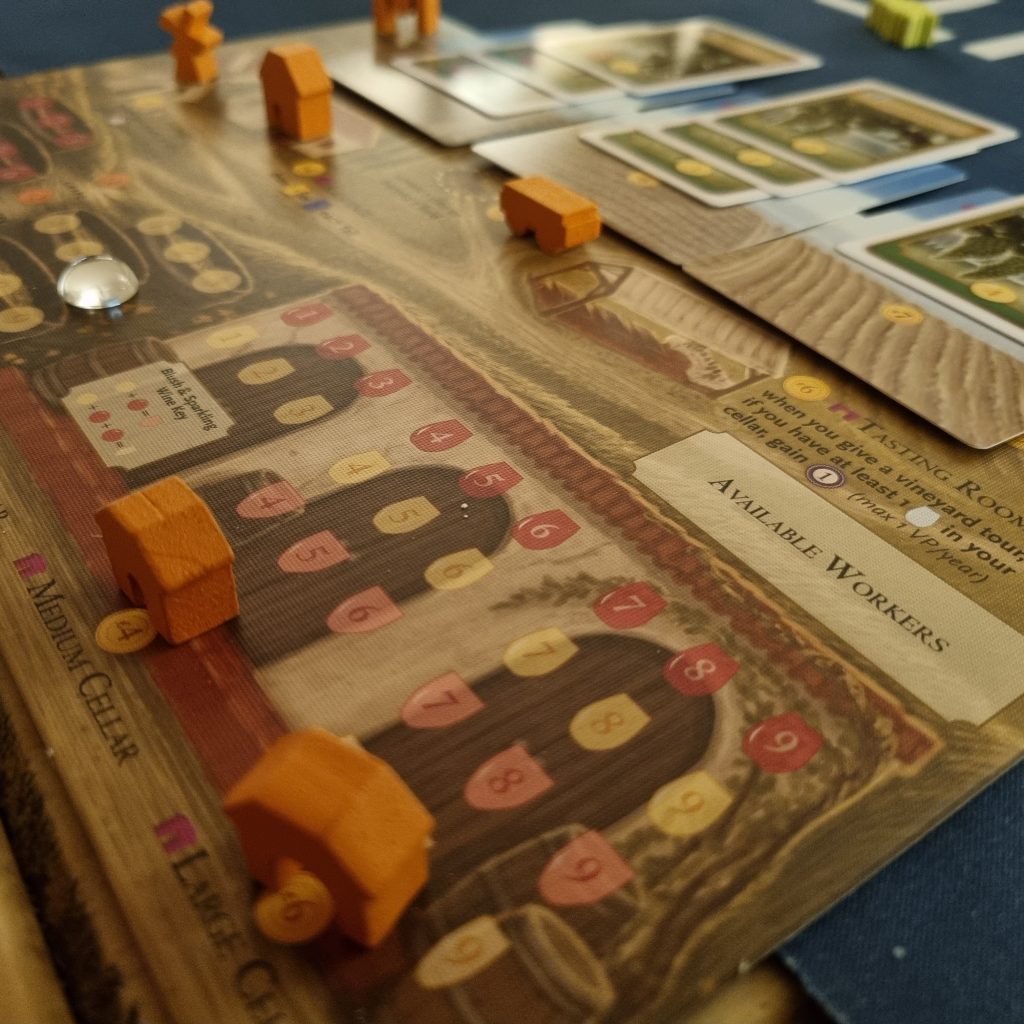
A Year in Tuscany!
Spring
A round in Viticulture is an annual cycle amongst the vines. Starting in spring, you choose your spot on the wake up track. This determines your turn order for that year and (unless you pick the first player spot) gives you a little bonus – this could be a card, a point, a coin, or even a temporary worker.
The juicier the bonus though, the lower down the track you’ll go. That means you could be left with some fairly dry action spots on the board when summer comes around (the early bird catches the winey worm!). Having said that though, as the game progresses, what you really need in spring is likely to change considerably. And with it, the utility of each of those little extras often gets cast into a different light!

Summer
Once the sun is at its most blistering, it is time to start placing your workers and taking actions. You won’t have very many to begin with – your opening legacy of inherited goodies (workers, coins, buildings, and cards) is determined by the Mama and Papa cards you chose at the start. Plus, with only a couple of workers for the whole of the first year, you are going to want to keep some in reserve for the winter season. After all, these wines won’t make themselves! See what I mean about decisions from the get-go?
Summer actions vary from planting vines, giving vineyard tours, building structures, and of course playing host to summer visitors. I should give particular mention to the structures at this point. From yokes to windmills to wine cellars; each one does something different and could be a wise investment. (if you decide to build at the right time of course)!
Now, I spoke earlier of spot nabbing. Well, it happens. A lot.
Although there are a 3 action spaces at each summer (and winter) activity on the board, once they’re gone, they’re gone! And depending on how many players there are around the table, they might not all be available anyway. In a busy 5 player game, all 3 spots (including the central ones which contain extra jubby bonus goodies for the player who gets there first) are open for business. By contrast, in a two player game, only the left most spot is available per season. And no bonus. Ouch!
You will, however, always have a GRANDE worker (thank you Papa!) who is worth their weight in wine! Because, although they can’t collect a bonus (unless they get to it first), they can double up on a spot already filled by your wiley, winey opponents. Tactical play grows strong in El Grande!
Okay sun worshippers; back to the board!

Autumn
Autumn comes once all players have finished with their summer toiling (i.e. passed), and everyone gets the choice of either a summer or winter visitor card. And the visitors are hella (as the kids are wont to say these days!) handy.
They give you chances to do things that you might not otherwise be able to do. Or even regular actions at a discount on the usual price. Or even something not otherwise permitted by the board – uprooting vines, taking cards from opponents, or profiting from their own actions etc.
I particularly like visitors like the Importer and the Swindler – characters who give the other players around the table a choice. When your opponents can take advantage of something your own visitor offers (e.g. building at a discount or taking an extra card) or stop you getting something, the trade-off in money or VPs can be high. And this can make for a crunchy choice on both sides of the board. The Planner who lets you place a worker in a future season in readiness and the Manager who lets you go back in time and do a summer action in winter are more personal favourites.
Now, given how many visitors there are, just like the asymmetry of the mama and papa starter cards, they add a magnum hit of viney variability to the game play. And that’s definitely our favourite flavour!
From personal experience, replayability in Stonemaier games is generally great. But visitors present options and choices that filter down through all the other strategic steps you’re taking. And with a decent amount of them ready to add another vineyard Trip Advisor review to their collections, each game throws up a different combination.
Plus deciding whether to get potential help in summer or in winter gives even more pause for thought. Especially as what you need most when is going to change over the course of each year. Some visitors won’t help now, but what about later? Some might even help others a little too much…….oh what sweet, delicious brain pain is this?!
I get that some won’t like the randomness of drawing unseen cards from a deck, and that’s absolutely fine. Because, in all honesty, you never have to use them. You’ll be taking at least one visitor card every autumn, and you can take action spots to play them (or even draw more of them). But you don’t have to. And as you have to discard down to 7 cards in your hand at the end of each year, they can be easy sacrifices if you’re not really feeling the luck factor!

Winter
When winter frosts fall, it’s time to place any workers you have left. Whilst spring and summer are all about prepping, growing, and schmoozing wine buyers, winter is where the magic happens. Winter is all about harvesting your fields, making up wines, and fulfilling wine orders. Tis the season to make points! Because, once you’ve got grapes on your crush pads and you’re making up wines to fulfil orders – red, white, rosé….even sparkling – you’ll quickly start jumping up the VP track. And, as Viticulture is a straight up race to 20 points, winter can be a bitter battle indeed!
Oh, I feel like I should mention that amidst all the bottling, it might be helpful to train more workers ready for next year. You don’t get the chance in summer and maxing out on workers could be a wise move to get more actions under your belt every season. I chose that as a strategy in my first ever game and it certainly saved me from a sour experience! More workers. Handy in a worker placement game? Who knew!
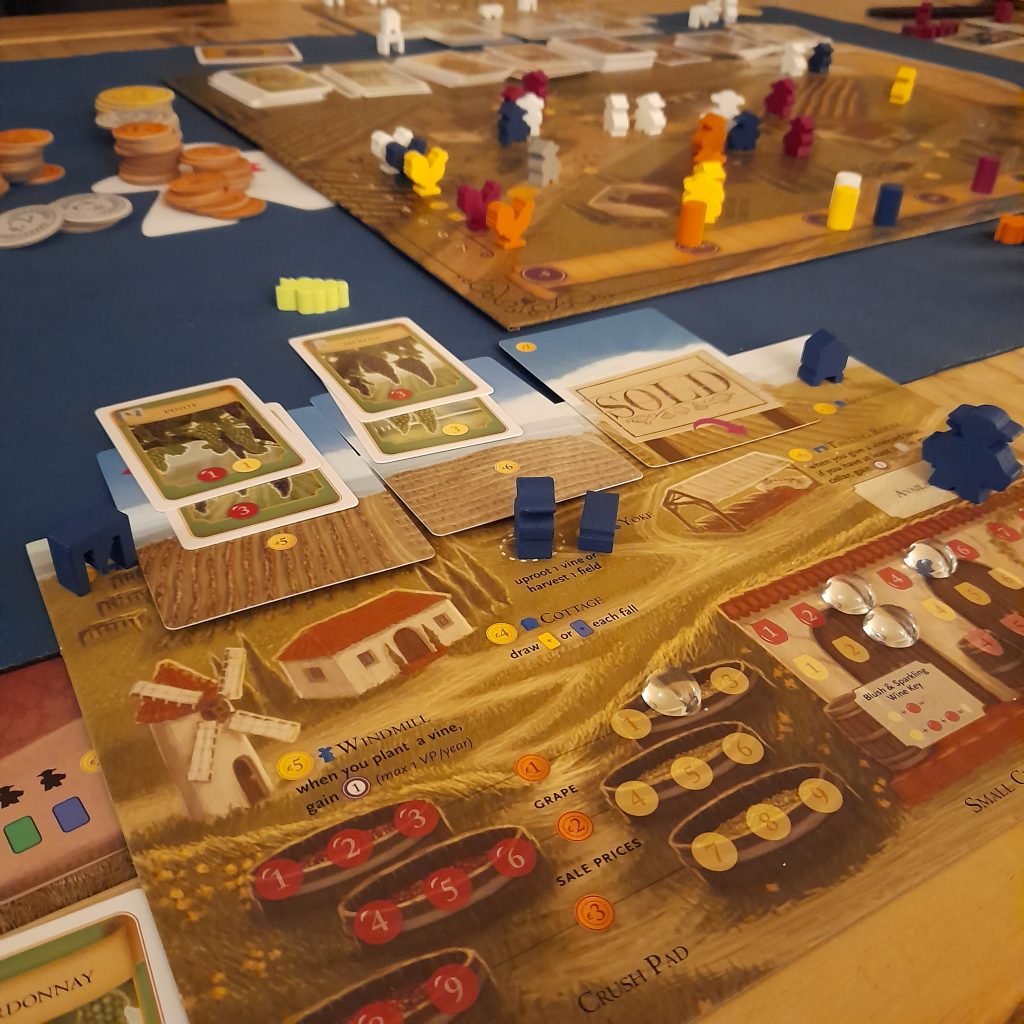
Year End
At the end of the year, all the workers return to base, and any grapes and wines still in the system are aged i.e. they increase in value by one (in the hope of being useful for a more complex, point heavy future wine order). Anybody who fulfilled a wine order will also get some juicy residual income to help them invest next round, and nobody will be able to stop themselves eyeing up their current position on the points track.
On that, if a player crosses the tasty twenty VP marker, that’s the trigger to end the game. Players take their final turn and then it’s time to congratulate the winning winer (whilst secretly or overtly plotting your next strategy to overthrow them!). If there is a tie for top spot, fear not – there’s a hierarchy of ways in which one will shine brighter than the others (handy hint: collect as much coin as you can if it’s looking crowded towards the end of the track!).

Elegance Bottled!
For what is at its heart a race to twenty points, Jamey Stegmaier and Alan Stone have cleverly managed to design a game that doesn’t look or immediately feel like you’ll be in any rush when playing it.
Setting up, you spy actions, cards, and coins. You see workers, buildings, and grape tokens. The artwork (by Jacqui Davis, David Montgomery, and Beth Sobel) gives the impression of sitting in the middle of old time Tuscany in the midday sun. Warm, subtle tones and understated icons mixed with detailed card art amplifies the relaxed atmosphere. But please don’t be fooled.
What looks to be an open board with a point-salady way of turning vines into VPs, is actually nothing of the sort. This game is TENSE. Underneath that chilled exterior, the struggle for first place fizzes like a Prosecco roped tight to a jack hammer.
We have now played Viticulture with a bunch of players, and we have played it as a tasty twosome. Depending on player count, the game definitely feels different, and playing time is equally affected. We currently run around 45 mins for a two player tussle, 60 mins plus as the player count rises. But there is always some degree of tension, none more so than at a two player count!
Higher player counts open up the board a little – 3 action spots and extra bonuses per activity at its most crowded. But that is of course balanced by the fact that there are more players with more workers to place every season. Still no day off for El Grande!
But at two player count, there is only one action spot per activity per year. And that is cheek-squeakingly tight! Putting it another way: when your competitor gets to do something that year, you don’t. At all. And that is exquisitely frustrating.
There is, however, always strategic salvation…… if you can figure it out.
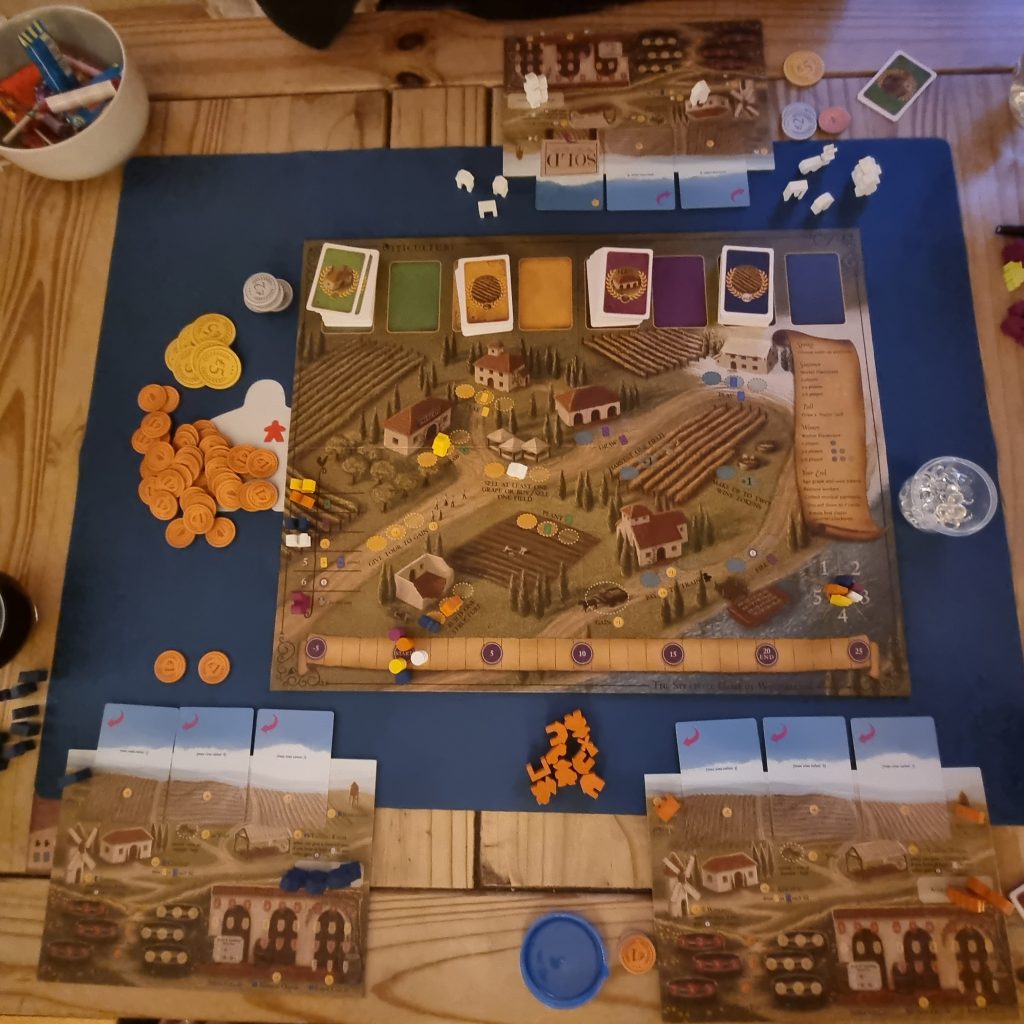
Strategic Sauvignon!
Because of restricted choices, you have to play smart. I find visitors play much more of a pivotal role in my strategy when going head to head with one other oenophile than when up against the Merlot mob. I don’t just want visitor cards; I need those extra actions and possible bonuses. And if they give something juicy to my opponent, well then, I am in serious dilemma territory!
Same with the structures. The yoke that enables me to uproot paltry vines or harvest out of season is a no-brainer when budgeting for buildings. But buying all the structures I want means my purse takes a big hit. A “no Lira left in the kitty for training workers” shaped hole. Which in turn obviously impedes what I can do on the board during next year’s main seasons. Because in worker placement games, what I want more than anything is workers. Lots and lots of willing workers.
And there is the elegant, understated awesomeness that is Viticulture. The process of playing is simple; you have a worker. You pick an action. Your worker does it. You make wine. If you get stuck, the rulebook is thankfully simple to follow and really detailed (including pointing out differences when playing with and without Tuscany). Like the game itself, the book and even the inserts inside the box are nothing short of classic top quality Stonemaier production (think Wingspan, Red Rising, Scythe etc.). I must confess to muddling up the tannin terminology in my first few games, but it quickly became familiar, and the rules were there for a quick reference check.
Every decision in Viticulture, no matter how small, has a knock on effect. From the very first choice you make (aka which Mama and Papa cards to take), to the final worker board drop, the consequences will be significant. They may not feel that way at the time, but they will be. The need to balance your actions, your budget, and your time is always essential. There’s no time to coast or laze in the warm sun. If you don’t piece together your piccolo puzzle and quickly, your efforts will be flatter than the grapes on your crush pads.
In Viticulture, you need to bring your tactical A game. And that brain exercise is toil of the most enjoyable kind. So on that plummy note, I am now limbering up for my first solo against the Automa Factory’s most veritable vintner (Morten Monrad Pendersen; what do you have in store for me???).
If you think this might be a game for your collection, you can always check out the lovely folks at Out of Town Games here
[please note that a copy of this game was kindly provided by the publisher for the purposes of this review, but any opinions expressed are my own]
[Please also note that I am not paid by any retail outlets to promote their products]



